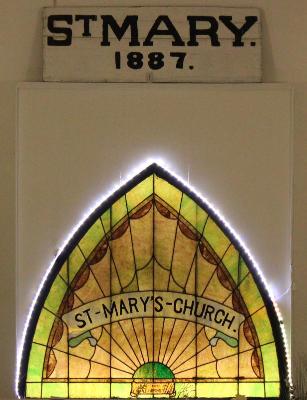Front Door, 1894 E.A. Everett House
Lost Waseca: Inside the 1890s E.A. Everett Mansion, 206 Ninth Street N.E.
Edward Addison “E.A.” Everett and Antoinette “Nettie” Miller grew up together in Waseca, the children of two of Waseca’s pioneers, Rinehart Miller and William A. Everett. They married on September 2, 1890 in the Miller residence at East Elm and 7th Street N.E. The following year Nettie gave birth to a son, William Rinehart Everett (named for his two grandfathers), and in 1902, a daughter, Constance Antoinette Everett. In the years between the births of the children, they built a magnificent house at 206 Ninth Street N.E. near the shore of Clear Lake.
In 2001 the surviving grandchildren of E.A. and Nettie donated two family albums filled with some 300 photographs, plus many photographs of the interior of the house as it was in 1898—seen by very few people outside of the family.
Architectural Artifacts Saved
Unbeknownst to Everett descendants, many architectural artifacts were saved that day in 1958 when the beautiful Victorian residence was razed. A Janesville resident, Ward Wendt, had salvaged columns, railings, mantels, cherry built-ins, fretwork, exterior elements like corbels, egg and dart molding, stained glass and beveled glass windows. Wendt graciously loaned and eventually donated the artifacts which included the magnificent 8-foot front door complete with lintel, pilasters, threshold and the doorbell. An exhibit was mounted in 2002 with the addition of many Everett family heirlooms—china, silver, crystal on loan from the family. However, the stars of the exhibit were the photograph enlargements of the home’s interiors. The images and artifacts continue to teach our visitors what 19th century life was like, providing just a glimpse of a grand style long since passed.
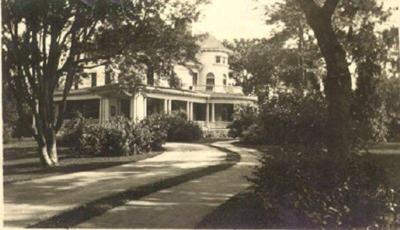
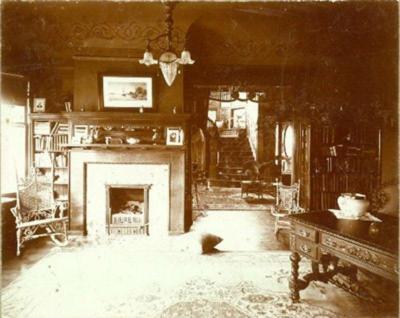
1956 Wurlitzer
The Wurlitzer 2000 “Anniversary Edition”jukebox entertained patrons of the Star Café in Waldorf, Minnesota for many years. Kids and teens spent hours feeding it coins to listen to Elvis, Johnny Cash, Brenda Lee, the Beach Boys, the Supremes and many other artists of the 1950s and 1960s. Former owners Andy and Erma Felber bought and sold the café several times between 1948 until 1959, when Andy died. Erma continued operating the café as a candy and snack shop until 1985. After the Star Café Jukebox was donated (for the cost of $10) to WCHS, it became a popular attraction for the tourists who gladly fed it with quarters again. Then it broke down and sat for several years until Karl Jones, a WCHS member, volunteered in 2011 to fix it. As a trained electronics technician for Hennepin County D.O.T., he was well qualified. After finding an original manual online, then sending for parts, Karl restored the jukebox to play any of the two-hundred 45-rpm records for our visitors once again. It’s the most popular artifact in the museum. Come in and play a tune, it’s free!
What is a jukebox? The name Wurlitzer and creating music dates back to 1659 in Europe. Rudolph Wurlitzer came to the U.S. in 1853 to sell musical instruments, but eventually sold coin-operated player pianos, and then coin-operated phonographs--popularly referred to as jukeboxes. The height of jukebox popularity came after Prohibition was repealed in 1933. Wurlitzer dominated the business until the introduction of the 45 rpm vinyl record. The jukebox remains one of the icons of mid-century popular culture.
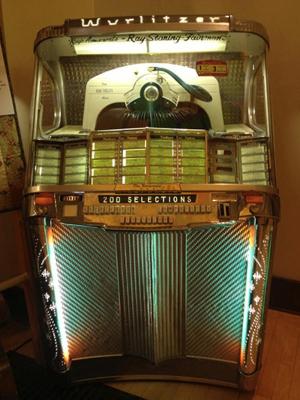
1948 Vendo Vertical Vending Machine
This Coca-Cola vending machine was used at the Alma City Creamery until it was donated to the museum in 1980. In 2012, Karl Jones a WCHS member volunteered to make our Coke Machine work again. Unfortunately, the Coca-Cola bottles it was meant to sell are no longer produced. This particular model held six cases and was designed to sell pop bottles in a grocery store. Just pull the bottle out of the machine and pay for it at the counter, in those days it was just 5 cents!
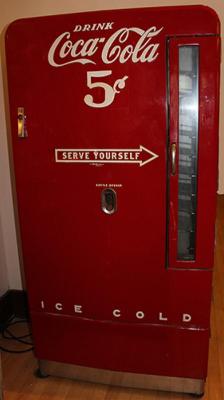
This organ was donated in 1894 by Mrs. Whittacker for St. John’s Episcopal Church of Janesville, in memory of her brother Jesse Willard Tefft. Mr. Tefft was the church organist and choir leader at St. John’s. The organ was in use until 1950 when an electric organ was purchased. The organ was later donated to the Society by the church.
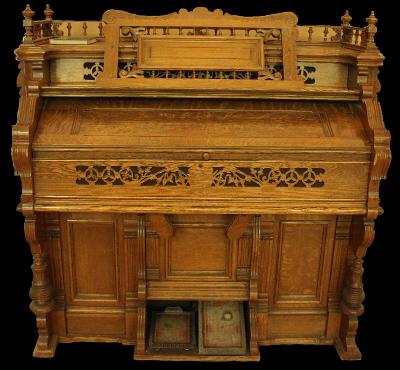
St. John's Episcopal Church, Janesville, shown c. 1975-1980
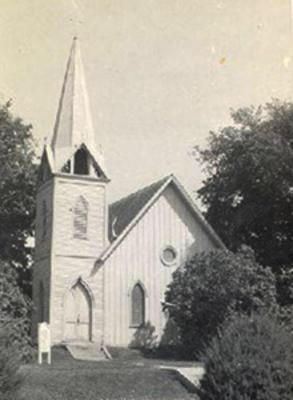
The church was originally built in 1875 and was the first Episcopal Church in Janesville. The small circular stained glass window was given by Bishop Whipple, head of the Episcopal Church of Minnesota. He was known to have befriended the Indian people during the 1860s. The arched stained glass window in front was given by the Winona & St. Peter Railroad Brotherhood. These two windows were removed and stored for a time at Joe Britton's farm. The circular window was given and installed at St. Paul’s Episcopal Church in Owatonna, MN. The arched window is now on display in the east stairwell in this museum. Another window is displayed in the west stairwell. The congregation disbanded by 1996. The building was sold and became an antique shop called "Church Belles."
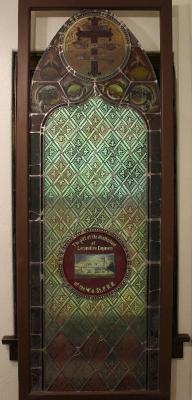
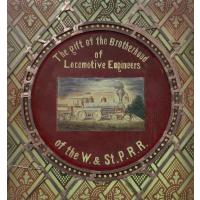
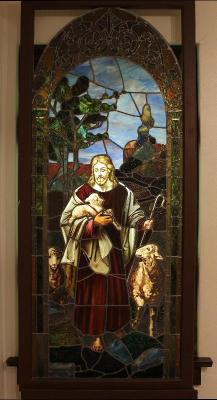
On the museum stage is the curved wooden table used by the early Waseca County commissioners after the city of Waseca became the new county seat in 1870. Waseca County was formed on February 27, 1857 designating the bustling town of Wilton as the county seat at that time. However, as the new railroad was about to be constructed, the route ran through Waseca instead of Wilton. There was a county wide referendum held that resulted in moving the county seat to Waseca. All records were delivered during the night to a new courthouse in Waseca that had been built in anticipation of the vote. It was ready for business the next morning. Previous board members believed that this table was first used by the commissioners in 1870. It fits five chairs nicely for meetings and receiving county residents.
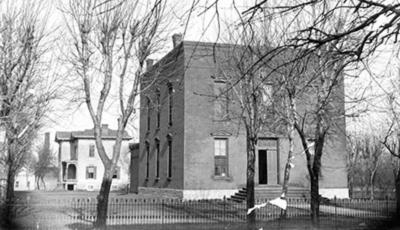
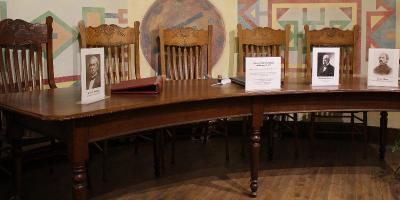
St. Mary Catholic Church, St. Mary Township, c. 1888
This beautiful Gothic stained glass window once graced the front of St. Mary Church above the main doors. It was given to the WCHS collection in 1972 after the church building was razed. St. Mary Catholic Church stood on the hilltop on what is now County Rd. 9 and was the oldest parish in Waseca County.
The window was rarely displayed because of its size and fragility. In 2008 during the museum’s township exhibit, the window was displayed just leaning against the back wall of the stage. Backlighting consisted of one up-light carefully positioned. The lead mullions were loose and areas of the glass composition were “bowing” dangerously, as if the window could collapse. After the exhibit it was decided to proceed toward restoration. A brief newsletter article describing the need brought forward many members with donations. The window was taken to the Gaytee Stained Glass Studio in Minneapolis for a month of careful work. Former board member, Don Wynnemer, designed and built a display base to permanently exhibit the window in the upper alcove of the museum—safe, sound, and lighted.
These are the generous donors: George and Jean McCarthy, M. Joan Byrne, Marianna Byrne Hill, Mary and Doug Carlson, Beverly Conway, Helen Curran, Mayone and Paul Byron, Joyce A. Beaumont, Sue Ann Glissendorf, Ann Tandberg, Don Wynnemer, and Keith Smith.
